How to Create a Picture Perfect Ecommerce Website With Product Photography

The human brain can process images in only 13 milliseconds — which means you don’t have much time to make a good first impression on your customers.
What shoppers see is often a deciding factor in whether they will stay on your site or lose interest, so it’s crucial that you invest in building an online store that catches their eye and keeps them intrigued.
One of the best ways to do this is through great product photography.
If you’re running an ecommerce business, you probably already know how amazing your products are, but until a customer has your product in-hand, all they have to rely on are the pictures on your website.
This is why the best ecommerce websites not only have great products, but also great photos of their products. These images testify to the quality and value of your products and establish transparency into your ecommerce business.
In this blog post, we’ll give you the full rundown on all things product photography so that you can be on your way to getting that perfect shot.
Types of Product Photography
Product photography isn’t one size fits all. Just as your ecommerce store likely features a variety of products and services, product photos also come in a variety of styles and purposes. Some are for everyday use, while others are more unique and only used in special cases.
Whether you want to maintain a consistent look across your product photos or tastefully mix and match them, it’s important to understand the difference between each type of product photography and how to best capture them.
Below we’ve compiled a list of the six most common types of product shots, when to use them and what they look like in practice:
1. Individual shots.
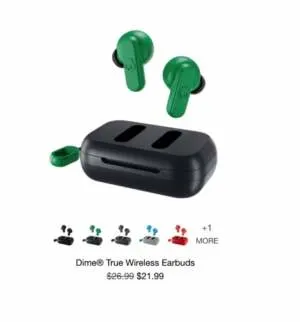
One of the most common types of product photos, the individual shot contains only one object in the frame. These are often featured in product catalogs, banner images and throughout product pages to showcase individual products independently from the full collection.
A great example is this one from Skullcandy, which is shot with a white background to create a clean, simple look and keep the focus on the product.
2. Group shots.

You guessed it — group shots showcase more than one product together.
Often used for product kits and collections, group photography displays the range and variety of your products and gives the customer a more complete view of your offering. These types of images are perfect for social media posts and advertisements, as they give shoppers a taste of your brand as a whole, rather than just one product.
3. Lifestyle shots.

This type of photography is where you get to show your products in action.
Often taken with a model, like this example from Peter Christian, lifestyle shots tell the story behind your product and show your customers how they can use them in their daily lives.
While lifestyle photos can complement individual shots on your product page, they’re also perfect for social media, emails, ads and other visual channels, because they catch the eye and make your products feel more personal.
4. Scale shots.

A common issue with shopping online is not being able to gauge the actual size of a product. While product descriptions may list the dimensions of an item, product photos can be deceiving.
But with scale shots, you can help your customers get a better idea of the actual size of a product by comparing it with other everyday items, similar to this example by Ivory. This will help your customers visualize your products in their everyday lives and increase their confidence when purchasing online.
5. Detailed shots.
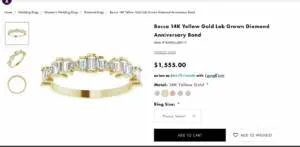
For products with small intricacies that require a close-up, including jewelry and other small items, detailed shots help highlight specific product features that a traditional photo might not catch.
This type of photography often requires specific light and camera settings, such as a macro lens, to capture those delicate shots.
6. Packaging shots.

Believe it or not, customers care about packaging.
From browsing your website to making a purchase and receiving their product in the mail, customers seek a shopping experience that is consistent from start to finish. So, even though you may have an amazing product, if your presentation isn’t up to par, your customers might take note.
And if your products come with beautiful, branded packaging, why not feature it on your product page to give your customers a taste of what to expect?
Packaging shots, like this example from Green Roads, feature not only the product itself, but also the product packaging, whether it be a box, bag or label.
Product Photography Tips and Process
Of course, for those of us who don’t know the difference between a Nikon or a Kodak, product photography can seem a little intimidating. And for small businesses on a budget, investing in expensive photography equipment simply isn’t an option.
Luckily, taking high-end photos is far more accessible today than it was 10 years ago. Considering most of us already have a 12-megapixel iPhone camera in our pockets, and many top-tier editing software is becoming more affordable, improving your ecommerce photography is probably simpler than you think.
Here we’ve highlighted some tips and practical steps for building your own DIY, at-home photography studio.
1. Set up your background.
Getting the right background not only keeps the focus on the product you’re photographing, but it also helps simplify the editing process when it comes time for post-production. Try using a white or light backdrop, as this will make it easier to remove unwanted objects and retouch photos.
Luckily, you don’t have to spend an arm and a leg on a fancy backdrop to get the perfect shot. There are a couple affordable options that will do the job:
Shooting table
If you’re going to have several photoshoots, you might want to order a white sweep off of Amazon. But if you want to go the homemade route, you can make your own chair-mounted sweep using a roll of white craft paper.
All you have to do is push the back of the chair against a wall and tape the craft paper on the wall above the chair, allowing it to fall to the ground. This will create a clean transition between the vertical and horizontal planes whenever you position your product on the chair.
Or, another option is to clamp the sweep to the top of the chair and allow the paper to drape down the chair, which will create the same seamless effect.

However, for larger products such as furniture, you’ll need to invest in a stand-mounted sweep like the one below. Or, you can use the same method as the chair-mounted sweep by taping white craft paper to the wall.
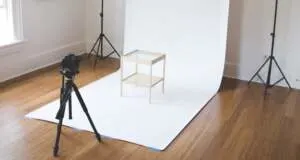
Light tent
Another affordable option for a backdrop is to build your own light tent, otherwise called a lightbox. This is a wireframe box with translucent walls which helps create an evenly distributed light around the object in focus.
To make your own, you’ll need a plastic storage container, placed on its side with the lid off.
Next, cover the bottom — and all the other sides, if you’re wanting a more evenly distributed light — with white paper.
Lastly, place an artificial light on either side of the container, or simply use natural light from a nearby window if you’re working on a budget.
2. Set up your product.
Now it’s time to bring your product into the spotlight.
It may seem simple, but setting up your product can take a few tries to get the angle, lighting and position just right.
Place your product in front of the backdrop, making sure that it’s centered and on a flat, stable surface like a table or chair.
For things like jewelry and other accessories, you may want to use a bust that better displays the product, and for items with labels or special designs, you may need to spend some time adjusting the product until it’s precisely centered.

For smaller, more intricate products, here are a few more tools that might be helpful:
Glue dots and tape for keeping small products in place, such as earrings or necklaces.
Mannequins for clothing and accessories.
Hangers or eye-catching flatlay for displaying products at different angles.
A friend or team member for modeling clothes or creating fun lifestyle shots.
3. Adjust your lighting.
One of the most important elements in capturing a quality product photo is having perfect lighting. Although it may be tedious to adjust, creating good lighting makes all the difference in an image, and you’ll definitely thank yourself later during the post-production process when you have fewer edits to make.
Luckily for product photography, you only have two types of light sources to choose from: natural light and artificial light.
Natural light
For those who are on a budget, using natural light is the best way to go. But just because this is the cheaper option doesn’t mean it’s lower quality.
On the contrary, natural light is actually ideal if you’re shooting outdoors or if you’re shooting a lifestyle photo with a model. Just make sure you’re shooting during the day when the sun is at its peak so that you can get optimal light.
If you’re having a product shoot indoors, place your backdrop and shooting table close to a window that gets a lot of natural sunlight, and if the light is too intense, you can try diffusing it with a light sheet or paper draped over the window.
A great example of when to use natural lighting is for food photography.
This product photo by Santa Monica Seafood. is a great example of natural lighting. Their website features a buffet of food photography, much of which utilizes natural lighting and gives their products a more dramatic effect.

Artificial light
If you have the budget to splurge on studio lights or you want to shoot during different times of the day when the sunlight isn’t at its peak, artificial light may be a better option.
What you’ll need are at least two softbox light setups, which will help soften shadows. You can find clip-on light clamps and strong bulbs on Amazon for about $30, or if you have the budget, there are plenty of higher-end options to choose from.
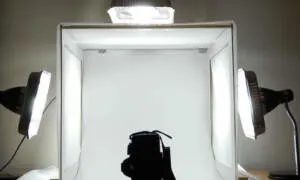
Once you have your studio lights, you can decide how you want to position them to achieve your desired look.
Regardless of how you adjust them, one should serve as your key light, placed in front of your product, and the other should be your fill light, positioned on the opposite side, back or above your product.
Although it is the lightboxes’ job to diffuse light, if the shadows are still too intense, you can always use a sheet or white cardboard to further soften the light.
Once you have your lighting setup just right, make sure to document the positioning and camera settings so you can recreate a consistent look from photoshoot to photoshoot.
4. Use a tripod.
To get that crisp-looking photo that captures every detail of your product, you’ll want to get a high depth of field, which ultimately determines the sharpness of the image. To achieve this, you’ll need to set your camera to a low aperture (a high f/stop) and slow shutter speed.
However, when your camera is on a slow shutter speed, it’s nearly impossible to hold it still enough with your hands to avoid ending up with a blurry photograph — and this is where a tripod saves the day.
5. Pick the right camera.
This might seem like a no-brainer, but choosing the right camera is essential to successful product photography.
Of course, if you’re not planning on doing photoshoots consistently, or if you’re on a tight budget, don’t feel pressured to drop a chunk of change on a fancy DSLR camera.
Luckily, smartphone technology has come a long way, so if you have an iPhone in your back pocket already, you’ll be good to go. You can always dress up your photos with your backdrop or play around with lighting to get that perfect shot.

However, if you’re looking to invest in a DSLR, here are some suggested camera settings:
Adjust your white balance (WB) to the same Kelvin temperature as your studio lights.
Set your aperture depending on the type of photo you’re taking. If you want to leave some parts of your product out of focus, then set your camera to a wider aperture. Or, if you want a sharp, focused look, then set it to a smaller aperture for a wider depth of field.
Turn your flash setting to Off — you won’t need it, since you’ll have already adjusted for natural or artificial light.
Set your camera to the highest quality image setting — if your camera has it, choose Raw, but if not, choose the largest JPG setting. Often you’ll see two setting options:
Size: Choose Large, which will give you the largest file size for the best image quality.
Quality: Choose Superfine, as this will use all the available pixels on your camera and thus give you the highest quality image.
Once you’ve adjusted to your desired settings, make sure to document them for easier setup the next time around.
6. Take multiple pictures and evaluate.
Finally, it’s time to see your product photography in action!
When you’re ready to start snapping, remember that the first few might be a little rusty, so feel free to take several. Take shots at different angles, distances and positions to see which one works best.
Once you feel like you’ve taken enough pictures, upload them to a computer to see how they turned out, since the tiny screen on your camera probably doesn’t give an accurate depiction. It might be helpful to use a program like Adobe Lightroom to organize your photos and begin editing.
7. Retouch your pictures.
Now it’s time for post-production.
Even though you hopefully already captured a few images you’re happy with, retouching your pictures is still a necessary step in the process. This will bring your photos from average to professional and ensure that all product images across your site have consistent quality, lighting and positioning.
Retouching allows for color correction, removal of unwanted objects and adjustments in lighting.
Of course, it may seem tedious at first, but after a few times around with the photo editing software, you’ll be able to fly through post-production in no time.
8. Optimize images.
Unfortunately, the larger the image on your ecommerce website, the slower the page load speed. But on the other hand, if you up your SEO, it can reduce the quality of your image.
Time is money, and many shoppers aren’t willing to wait around for an online store that isn’t loading fast enough. So, it’s vital that you optimize your images to achieve the best quality possible but also keep an eye on the page load speed.
Luckily, there are free minifying tools to optimize your photos and help you find that balance.
Lastly, make sure you name your product photos correctly and include metadata and keywords that will help improve your search ranking.
The Two Types of Ecommerce Product Photos
While there are lots of ways to get creative with your photography, there are two main types of product images that are necessary for different circumstances, so you’ll want a good mix of both across your product page.
1. Clean-cut, white background, product-only images.

These are often the most common type of image you’ll see across product catalogs and product pages. With the simple, no-frills background, these photos focus primarily on the product itself, often displaying the item from multiple angles and distances.
2. In-context or lifestyle photos.
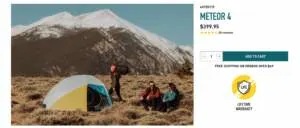
To really bring your brand to life, these photos feature your product in action, often photographed with a model or other complementary products. This helps your customers envision what it would look like to use your product in their everyday life and create a more personal connection with your brand.
Tools to Get Started With Product Photography
Now that you know the process of creating an eye-catching product image, it’s time to gather the necessary tools.
Although you definitely can go all out on top-knotch photography equipment, if you’re just starting out, feel free to take the DIY route. Here are a few things you’ll need to get started.
1. Shooting table.
To display your products during a photoshoot, you’ll need a surface that’s stable and sturdy. This can be a table, a chair or, if you’d like, a professional shooting table sweep — there are plenty of good options on Amazon.
2. Light tent.
As mentioned before, you’ll need something to use as a backdrop, such as a light tent (aka lightbox), which you can build on your own using a plastic storage container and a white cloth or paper.
3. Studio lighting.
Unless your photo studio gets good natural light, you’ll want to invest in some decent studio lights — at least two softbox light setups. These will help diffuse harsh lighting and adjust for shadows to achieve desired results.
4. Tripod.
Setting your camera on a tripod will allow you to achieve consistently clear and focused product images time and time again. Luckily, you can buy them for as little as $20 on Amazon, and they’ll last you for several years.
5. Mobile grip.
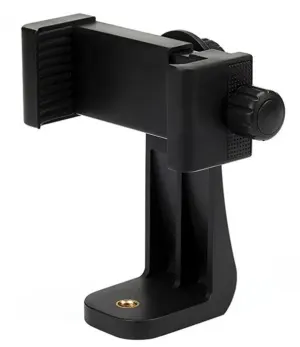
If you’re shooting with a camera, it likely already has a screwhole in the bottom that attaches to the top of a tripod. However, if you’re using an iPhone for your photoshoots, you’ll need a mobile grip like the one below to grip the smartphone into place and screw it into your tripod.
6. Photo editing software.
As the final step in your product photography process, you’ll need access to some sort of imaging editing tool — luckily, there are several free options on the market.
Adobe Photoshop (they also offer tons of free tutorials to help with all of your photo editing needs).
7. Photography guidelines for consistency.
As you continue to take more photos of your products, it’s important that you maintain a consistent style across all images. To help with this, try creating your own technical style guide and template, making sure to include these key elements:
Color Palette.
Saturation.
Focal Length.
Shadows.
Composition.
Location and Context.
Consistency.
Why Product Photography Increases Conversions
We are highly visual consumers. So, while the quality of your copy and product may be top tier, if your product images don’t match that same quality, your customers will notice.
Your photography represents your product’s quality and value as well as your brand image as a whole. If done well, it has the potential to increase conversions and drive sales in the long run.
1. High-quality images enhance every buyer touchpoint.
According to studies by Justuno, 93% of shoppers say that visual appearance is the key deciding factor in their purchasing decisions.
If that’s the case, then your product photos shouldn’t be left on the backburner.
Most interactions that a customer has with your brand should contain some sort of illustration that helps them envision your brand instead of simply reading or hearing about it. This means your product photos shouldn’t simply stop at your product pages — they should be weaved throughout your social platforms, advertisements, packaging and more.
A beautiful example of this is luxury jewelry brand Ippolita.
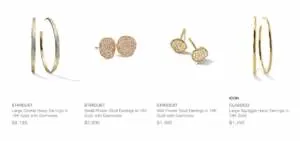
With a mix of product images, lifestyle shots and videos scattered across its site from the homepage to the final checkout, every stage of the purchase journey contains a visual element that keeps the shopper engaged.
2. Product images are a key element of branding.
Branding doesn’t stop at your packaging label or the logo on your website — rather, it should be the foundation for every element of your business.
With the help of product photography, you can tell your brand story through your social media posts, email updates, marketing events and digital ads.
Bliss World, a clean, cruelty-free, planet-friendly skincare brand, does an amazing job of conveying its brand image through product photography.

The website’s product images are splashed with light and color, giving the brand a fun, youthful feel. Plus, these images stay consistent across all of Bliss World’s channels, all the way from its ecommerce page to its digital ads to Instagram and Facebook.
When to Consider Hiring a Professional Product Photographer
Although you don’t need to be an expert to create beautiful product photography, like any DIY project, there may be some limitations.
Of course, professional product photography can get pricey, but if you have the budget for it, it’ll be worth the investment. Here are a couple reasons why:
1. Professional quality.
Unless you’re an experienced photographer, you likely don’t have the necessary equipment and software to achieve the highest quality photos. The quality of your equipment usually determines the quality of your photography and, most likely, a professional photographer will come loaded with the best of the best.
A talented photographer paired with top-notch equipment is a formula for high-quality product photos, and this is guaranteed to show on your website.
2. Consistent editing.
Especially if you work with the same photographer multiple times, they’re likely to provide consistency in both quality and style time and time again.
If you’re an amateur photographer without much experience in photo editing software, it may be difficult to recreate the same lighting, color and positioning every time, but this is a professional photographer’s forte. They’ll be able to provide you with consistency in brand image and quality, which will hopefully lead to consistency in the customers who visit your store.
Your Options for Professionals
If you’re looking to hire a professional photographer, here are a few product photography services that can help you in your search:
ProductPhotography.com: This platform is an easy option if you don’t have time to seek out a specific photographer. ProductPhotography.com allows you to fill out an order form online and ship them your products, and once their photographers have your products in-hand, they’ll photograph them for you and send them back via online delivery.
Thumbtack: If you’re searching for a professional in your area, Thumbtack is a great option for finding expert product photographers within a range of budgets. The website displays profiles for each photographer, which include ratings, the number of previous hires and a portfolio of their work.
Squareshot: With locations in New York, Los Angeles, Austin and Chicago, Squareshot allows merchants to ship products to their studio and receive high-quality product photos within a matter of days.
Wrapping Up
And there you have it — a toolbelt of tips and resources to revamp your product photography and start reaping the rewards.
Needless to say, you definitely do not need to implement all of these improvements at once. Creating consistent, high-quality product photos is not something that happens overnight, so it may take some trial and error to achieve the results you want.
However, once you’re in the swing of things, you’ll be able to wield your product photography to not only take beautiful product photos, but more importantly, create a visually compelling brand and successful ecommerce business.

Haylee is a Content Marketing Writer at BigCommerce, where she partners with the SEO team to craft narratives and blog content. She earned a B.A. in English Literature from the University of Texas at Austin and afterward spent a year abroad to pursue a Master's in International Management from Trinity College Dublin. When she’s not writing, you can usually find Haylee with her nose in a book, enjoying live music or scoping out the best local coffee shops.


